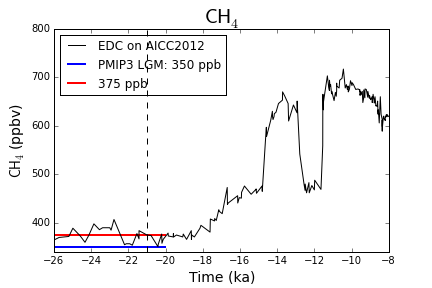Table of Contents
Last Deglaciation Greenhouse Gases
Go back to the main core experiment design page.
Go back to the main working group page.
Please use the Discussion section below to specifically comment on the choice of greenhouse gases for the core experiment.
Carbon Dioxide
The composite record (EPICA Dome C, Vostok and Taylor Dome) from Lüthi et al. (2008)[1] provides CO2 data spanning 800 ka to present.
The data will be provided on the AICC2012 timescale of Veres et al. (2013)[2].
Comparison of CO2 records and the PMIP3 LGM: 1)
 In particular, note how the new AICC2012[2] age model affects the timing of the record and the 'LGM' (21 ka; vertical dashed line) CO2 value; now 188 ppm compared to 185 ppm in PMIP3. There are also differences in timing and in the LGM value compared to the higher resolution Marcott et al. (2014)[3] record.
In particular, note how the new AICC2012[2] age model affects the timing of the record and the 'LGM' (21 ka; vertical dashed line) CO2 value; now 188 ppm compared to 185 ppm in PMIP3. There are also differences in timing and in the LGM value compared to the higher resolution Marcott et al. (2014)[3] record.
We are proposing to use the composite record of Lüthi et al. (2008)[1]; as per the magenta and red lines.
Methane
The EPICA Dome C record from Loulergue et al. (2008)[4] provides CH4 data also spanning 800 ka to present.
The data will be provided on the AICC2012 timescale of Veres et al. (2013)[2].
EPICA Dome C and the PMIP3 LGM 2)

Also note how the new AICC2012[2] age model affects the 'LGM' (21 ka; vertical dashed line) CH4 value.
Nitrous Oxide
The TALDICE record from Schilt et al. (2010)[5] provides N2O data spanning 140 ka to present.
The data will be provided on the AICC2012 timescale of Veres et al. (2013)[2].
TALDICE and the PMIP3 LGM 3)

The old PMIP3 'LGM' (21 ka; vertical dashed line) CH4 value, probably remains representative of the glacial period for the model spin-up, although the 21 ka value for the transient run will be lower, as per the record above.
Points to discuss
Please think about the following points and add any comments on these or any other aspects of the experiment design to the discussion section below: [Topics will be added here as they are raised below or by email.]
- RESOLVED With the new AICC2012[2] age model, the LGM values for CO2[1] and CH4[4] are inaccurate, as can be seen from the plots above. Do we need a new PMIP LGM definition for these greenhouse gases in accordance with the records? DECISION (Oct 2015): We have used the new, up to date CO2 (188 ppm) and CH4 (375 ppb) values for our LGM equilibrium-type 21 ka spinup. We do not know what the LGM group's decision will be.
- RESOLVED N2O[1] values take a dive in the lead up to 21 ka. The PMIP3 value of 200 ppb looks fairly representative of the LGM state, even though this is a bit higher than the actual 21 ka value. We recommend that groups spin-up with 200 ppb N2O, and begin the transient simulation from 21 ka in the record (as shown in the plot above). DECISION (Oct 2015): We have stuck with the old, more representative N2O value of 200 ppb. However, the transient 'spinup' 26-21 ka and the transient run (21-9 ka) should use the chronologically accurate values, as plotted above. We do not know what the LGM group's decision will be.
- RESOLVED Should the core experiment use the Marcott et al. (2014)[3] CO2 records?
For example, these newer data are higher resolution than Lüthi et al. (2008)[1], but are restricted to 23-9 ka. Therefore more consistency may be be gained from using the older Lüthi et al. (2008)[1] CO2 records, if longer simulations are planned by groups. Also, CH4 and N2O data are not yet available in such high resolution. DECISION (Oct 2015): We have chosen to use the older data from Lüthi et al. (2008)[1].
References
- Lüthi, D. et al. High-resolution carbon dioxide concentration record 650,000–800,000 years before present. Nature 453, 379–382 (2008).
- Veres, D. et al. The Antarctic ice core chronology (AICC2012): an optimized multi-parameter and multi-site dating approach for the last 120 thousand years. Clim Past 9, 1733–1748 (2013). 10, 297–317 (1991).
- Marcott, S. A. et al. Centennial-scale changes in the global carbon cycle during the last deglaciation. Nature 514, 616–619 (2014).
- Loulergue, L. et al. Orbital and millennial-scale features of atmospheric CH4 over the past 800,000 years. Nature 453, 383–386 (2008).
- Schilt, A. et al. Atmospheric nitrous oxide during the last 140,000 years. Earth Planet. Sci. Lett. 300, 33–43 (2010).
[ PMIP3 Wiki Home ] - [ Help! ] - [ Wiki syntax ]

Discussion on core experiment greenhouse gases
I think it makes sense to not use the Marcott data - they are offset from other Antarctic ice core values by about 4 ppm, consistently. The cause for this is still unresolved. Given that it wouldn't be easily spliced into a longer record, and the fact it is only between 23-9 ka, it is probably best to stick with the Luthi et al record.
For the N2O I agree that the 200 ppb looks representative of the LGM state and should be used.
I agree that 185 ppm CO2 and 350 ppb CH4 are underestimates on the new timescales. I think the record values at 21 ka look more representative of the LGM state.